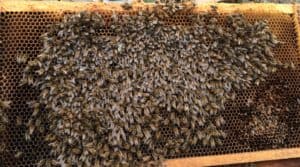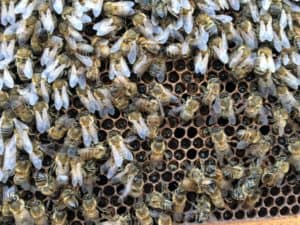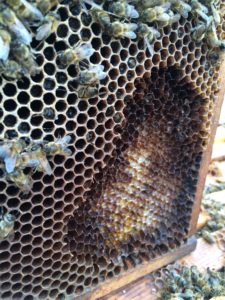Disclaimer: It is sometimes difficult to piece together a post-mortem of your hive. The best way to get your bees to overwinter is to plan ahead. It is disheartening when hives die, but you are planning ahead *RIGHT NOW* to increase your survivorship by learning more.
A few questions:
- How heavy were your brood boxes going into winter? Did the bees have enough resources to make it through winter? In Minnesota, we build up our colonies into 3 deeps and leave 75-100 lbs. of honey for the bees to make it through winter and 3-5 frames of pollen to give the bees enough protein to begin raising brood in February. See: Link to wrapping poster There are different overwintering needs for honey bees in different areas. Check with your local beekeepers association or find a mentor to help you.
>Evidence of a starved hive: (cluster of bees on empty frames with dead bees filling the cells):



- Did you measure and keep notes on the bees’ varroa mite numbers throughout the season? In particular, what were your mite numbers going into winter? If they were high (as determined by your local beekeeping association), did you do something about it? (treat with a miticide/acaracide, remove capped drone comb, brood break, etc.)? Did you treat soon enough in the season so the treatment or intervention had time to work according to the label, or to do some good?
After you intervened, did you check the mite levels to see if the mite numbers went down? If you don’t check AFTER the treatment or intervention, how will you know if it worked? There are a few indications that your hives had high mite levels: Deformed Wing Virus (DWV), Parasitic Mite Syndrome (PMS), and small bees. See here for more info and photos.
If you didn’t check your mite levels, don’t fret. Start this season. Learn the good, bad, and the ugly about your hives so you can make informed decisions about what might (and might not) be impacting your hives.
Secondary things that can occur in your hive after your bees are dead or dying: (robbed colony-ragged comb, mice damage, mold, crystallized nectar).
>Robbed colony (ragged empty comb, a lot of detritus on the bottom board, maybe dead bees, maybe not):

>Mice damaged colony (turds, urine smell, chewed frames (wood and wax), maybe nest material in the bottom of the box:

>Moldy bees or cells:


>Crystallized nectar in cells:

Photo credit: Chris Kulhanek
***In all of the above photos, the comb is still usable and bees will clean out the comb and use it.
Good news! You get to start over this year. Make plans to winter your colonies now. Think about how you are going to manage them so they have few mites, enough bees, and lots of honey for overwintering. If you’ve successfully overwintered a hive, consider re-queening after 2-3 years to keep the hive as strong as possible.
The more information we have, the better answers we are going to get. Check out the preview of the Colony Loss Survey here and please consider participating. Click here to get on our email list and participate in the survey.
The survey goes live April 1st!